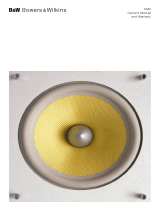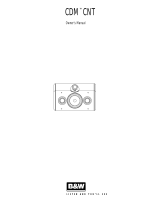
Contents/Inhalt/Sommaire/Índice
Safety notes 3-4
Setting up 5-6
Stands and wall mounts 6
Connecting up your amplifier 6-9
Beware of clipping 10
Tips for better acoustics 10
Care of loudspeakers 11
What to do if your speakers don‘t sound right ? 12
Sicherheitshinweise 13-14
Aufstellung 15-16
Stative und Wandhalterungen 16
Anschluss an den Verstärker 16-19
Vorsicht Clipping 20
Tipps für eine bessere Akustik 20
Pflege der Lautsprecher
21
Was tun in Störungsfällen ? 22
Sécurité 23-24
Installation 25-26
Pieds et supports muraux 26
Raccordement 26-29
Attention au «clipping» 30
Conseils pour une meilleure acoustique 30
Nettoyage des haut-parleurs 31
Que faire en cas d’anomalies ? 32
Seguridad
33-34
Disposición 35-36
Soportes de pie y de pared 36
Conexión al amplificador 36-39
Cuidado con el Clipping 40
Consejos para una mejor acústica 40
El mantenimiento de las cajas acústicas 41
¿Qué hacer en caso de avería? 42
ENGLISH
FRANÇAIS
ESPAÑOL
DEUTSCH
First of all, thank you for deciding on quadral loudspeakers.
It is to satisfy the high expectations of music lovers and connoisseurs
such as you that we build loudspeakers of a class that is well above
average. Even though you may already be familiar with them, we list
below a few ground rules that will enable you to make optimal use of
your loudspeakers.
Safety advice for passive loudspeakers
Please take time to read through the manual carefully and follow all the steps describing
how to set up and operate the loudspeakers. Keep the manual somewhere you can
quickly access it should you have any questions later on.
• The stability of loudspeakers (especially large units) depends on the nature of the
surface on which they stand. Carpets are often very poor for stability. Even an
average bump can cause a loudspeaker to fall over and be a hazard for persons
or pets in the vicinity. Stability can be significantly improved by using “spikes”, but
care should be taken during assembly as the sharp points can cause injury and the
spikes can damage the floor. On smooth floors, the loudspeakers can be stabilised
with Velcro or double-sided tape. Loudspeakers should never be used as a seat or as
a substitute for a ladder!
• Use only wheeled furniture, stands or wall mounting systems and other devices for
attaching and installing the products, which are available from the manufacturer and
are sold for or with the product. To avoid damage or injury through tipping over,
please be careful when moving table devices or stands on which the speakers are
mounted. If wall-mounting the product, take special care that all components are
securely screwed! Additional securing equipment (chains, etc.) should be fitted.
• The location for the loudspeakers should be dry and not too cold. Constant high
humidity or strong sunlight (UV radiation) can cause your loudspeakers to age
prematurely and consequently affect their functioning.
• Very high volume levels for long periods of time are not only annoying for your
neighbours, but can also be harmful to the health of the user!
• When loudspeakers are overloaded with very high volume levels, there is a risk
of individual components in crossover circuits or individual speakers burning out.
In particularly bad cases, it is even possible for fire to break out inside a speaker.
Speakers operated at these extremes should therefore not be left unattended.
• At high volumes, voltage levels of 30–50 V can be present at speaker terminals and
components. Be very careful not to touch uninsulated terminal contacts of speakers
BDA allgemein 17.10.indd 2-3 01.11.2005 10:11:29 Uhr











